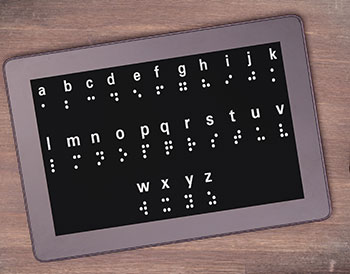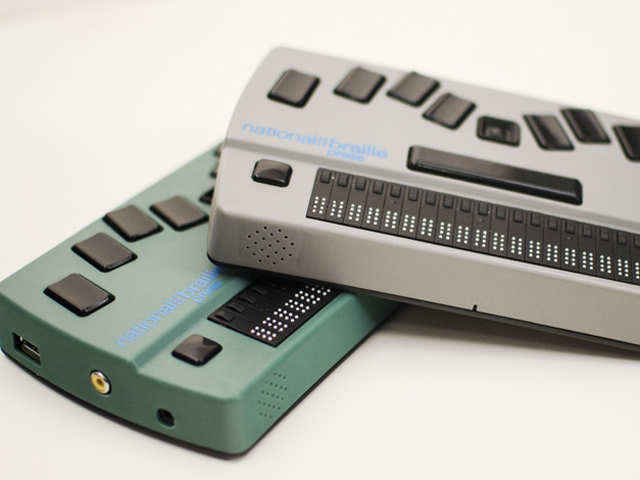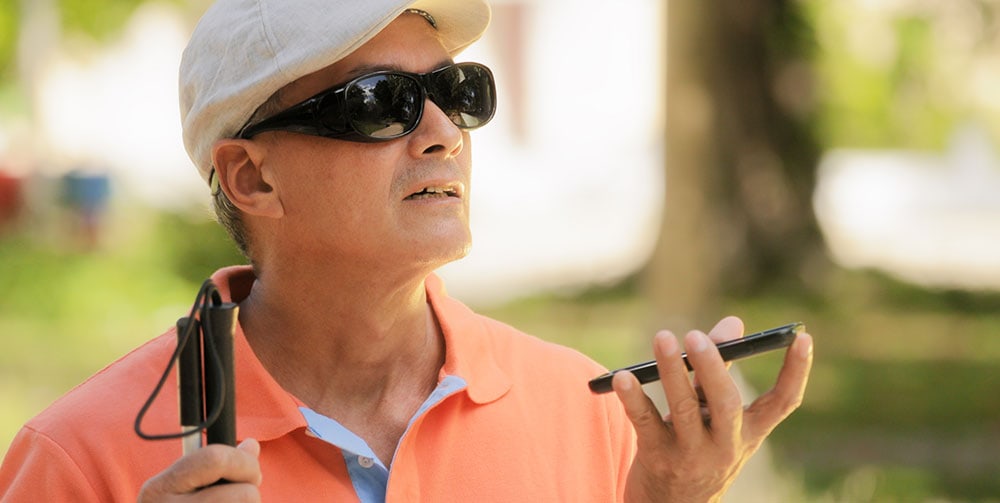Enhance Accessibility with Braille Displays and Notetakers
Enhance Accessibility with Braille Displays and Notetakers
Blog Article
Discover Cutting-edge Devices Designed for the Visually Damaged
The advancement of ingenious devices for the visually damaged represents a significant advancement in availability and freedom. Technologies such as wise glasses with AI capabilities and mobile applications developed to offer acoustic summaries are improving daily experiences for users. Additionally, wearable tools that utilize haptic comments enhance environmental recognition, while modern-day Braille technologies offer new methods to engage with text. As these devices proceed to advance, their impact on the lives of those with visual impairments elevates important questions concerning the future of inclusivity and freedom in numerous aspects of life. What exists in advance in this technological landscape?
Smart Glasses for Navigating

Smart glasses created for navigation are reinventing the way aesthetically damaged people connect with their atmosphere. These advanced tools use a combination of camera innovation, fabricated knowledge, and acoustic responses to offer real-time info regarding surroundings. By employing obstacle discovery systems, smart glasses can inform individuals to potential dangers, allowing much safer wheelchair in both unknown and familiar settings.
The combination of GPS technology even more boosts navigating capabilities, enabling users to receive auditory directions as they move. This hands-free approach not just promotes independence but additionally equips visually damaged people to browse city landscapes with enhanced self-confidence. Furthermore, several wise glasses are equipped with attributes that recognize sites and street indicators, providing contextual information that boosts the user experience.
Furthermore, the growth of these gadgets is continuously progressing, with business functioning to enhance the precision of item recognition and broaden the variety of navigational functions. As smart glasses come to be more cost effective and obtainable, they hold the prospective to significantly change every day life for visually damaged customers. Inevitably, these ingenious devices represent a critical step toward inclusivity, offering improved flexibility and a higher feeling of freedom for people navigating the globe around them.

Mobile Application for Daily Living
How can mobile applications boost the day-to-day lives of aesthetically impaired individuals? Mobile apps are changing the means aesthetically impaired customers navigate their atmospheres, handle day-to-day tasks, and accessibility information. These applications offer vital assistance through numerous performances, promoting freedom and enhancing high quality of life.
Several innovative mobile apps are created specifically for everyday living. Apps like Be My Eyes attach aesthetically impaired customers with sighted volunteers via video telephone calls, permitting them to obtain real-time assistance with jobs such as reading tags or navigating strange areas. Seeing AI, established by Microsoft, utilizes artificial knowledge to explain surroundings, read text, and determine things, properly transforming a smartphone right into an effective device for day-to-day aid.
In addition, navigation apps tailored for the visually impaired, such as Aira and BlindSquare, use audio-based instructions and ecological details, allowing individuals to traverse their surroundings safely and with confidence. Beyond navigation and immediate support, mobile apps likewise support organization and task monitoring, with features that assist individuals establish reminders, produce to-do listings, and track consultations. In summary, mobile applications function as indispensable sources, empowering visually impaired individuals to lead more independent and meeting lives.
Wearable Technologies for Support
Empowerment with technology is progressively noticeable in the world of wearable devices designed to help aesthetically impaired people. These ingenious devices incorporate seamlessly into life, enhancing navigation and giving essential responses to individuals. For example, wise glasses equipped with cams can recognize faces and read text aloud, permitting customers to connect even more with confidence in professional and social setups.
An additional significant improvement is using haptic comments systems in wearable devices. These systems make use of resonances or various other tactile signals to share info concerning the customer's environment, such as challenges or modifications in terrain, boosting mobility and safety and security. Wearable technologies also include wristbands that connect to smart devices, notifying users to notices with refined resonances, hence enhancing connectivity without dependence on aesthetic cues.
As these innovations remain to develop, they are not only enhancing self-reliance for aesthetically impaired people yet additionally promoting a greater feeling of addition in culture. By linking the space in between challenges dealt with in daily living and the capacity for freedom, wearable technologies function as pivotal devices in the mission for equal rights and empowerment for those with visual disabilities.
Sound Summary Devices
Sound description devices play an essential function in boosting access for aesthetically impaired individuals, providing them with the ability to involve with aesthetic media. Smart glasses for the visually impaired. These tools supply narrated descriptions of essential visual aspects in films, tv programs, and live efficiencies, making certain that individuals can fully understand the context and feelings communicated via visuals
Audio summary can be integrated into numerous platforms, consisting of streaming services, cinema screenings, and live cinema. Numerous popular streaming services now include audio description as an access feature, enabling visitors to choose it quickly. Along with traditional media, specialized applications likewise exist, supplying audio summaries for art events, museums, and other cultural events.
The effectiveness of audio description depends upon the ability of the storytellers, that should communicate aesthetic information succinctly without diminishing the initial audio. Advancements in this area are also leading the way for more personalized experiences, where customers can change the level of detail and pacing according to cheap eye glasses their choices.
Braille Innovations and Devices
Braille advancements and devices have significantly transformed the method visually impaired individuals communicate with text and details. Modern innovations have actually led to the development of flexible devices that improve proficiency and self-reliance among users.
Moreover, mobile Braille notetakers integrate conventional Braille input with contemporary performances, assisting in note-taking, organizing, and paper editing and enhancing on the go. Screen readers for the blind. These small devices usually include text-to-speech abilities, connecting the gap in between Braille and acoustic information
On top of that, ingenious Braille printers have emerged, permitting customers to create Braille tags, files, and academic products successfully. This ease of access cultivates higher participation in educational and professional environments, eventually advertising inclusivity.
Furthermore, research into visit site clever Braille technologies remains to expand. Gadgets that integrate synthetic intelligence are being discovered to provide real-time navigating aid and contextual information, enhancing the customer experience in varied setups. On the whole, these innovations show a commitment to encouraging visually impaired individuals with technology, guaranteeing they can conveniently accessibility and involve with the world around them.

Conclusion
The improvement of innovative tools for the aesthetically impaired dramatically boosts independence and lifestyle. Smart glasses, mobile applications, wearable modern technologies, audio summary devices, and Braille developments jointly empower people by providing essential navigating aid, ecological awareness, and enhanced reading experiences. These innovations not only foster higher incorporation but also advertise autonomy in daily tasks, eventually adding to an extra equitable and available culture for visually damaged people. Proceeded development in this field holds assurance for additional enhancements.
As clever glasses end up being more economical and easily accessible, they hold the prospective to dramatically transform daily life for aesthetically damaged individuals. Mobile apps are revolutionizing the method visually damaged individuals navigate their environments, handle everyday jobs, and gain access to details. Applications like Be My Eyes connect visually damaged users with sighted volunteers via video clip phone calls, enabling them to get real-time support with tasks such as reading tags or navigating strange rooms.Additionally, navigation apps customized for the aesthetically damaged, such as Aira and BlindSquare, provide audio-based directions and my explanation environmental details, allowing users to traverse their surroundings securely and confidently.The advancement of cutting-edge tools for the visually impaired significantly boosts self-reliance and top quality of life.
Report this page